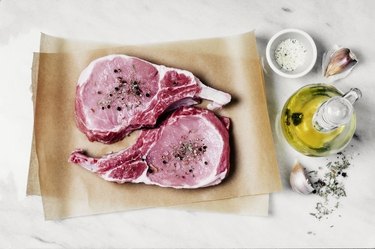
Although iron is an essential mineral required for your body to function properly, too much iron in the body can be dangerous. People with hemochromatosis — a rare hereditary condition that occurs when too much iron builds up in the body — often need to limit their dietary iron intake to help prevent iron toxicity.
Also people with multiple blood transfusions may be at risk of having iron overload in the body. Too much iron in your body can cause liver damage, diabetes and discolored skin, notes the University of Maryland Medical Center. Making dietary changes can help lower iron levels.
Video of the Day
Video of the Day
Heme Vs. Nonheme Iron
To properly lower iron levels in your body with food, it's important to understand the difference between heme and nonheme iron. Heme iron is found in animal-based food products — such as red meats — and is better absorbed by your body than nonheme iron found in plant-based foods.
Eating certain foods with nonheme iron helps enhance its absorption, however. Therefore, the type of iron-containing foods you're eating is just as important as your total dietary iron intake.
Limit Iron-Rich Foods
Avoiding foods that contain high amounts of iron, especially heme iron, helps lower iron levels in your body — which is beneficial if you have hemochromatosis.
Such iron-rich foods to avoid include oysters, red meat, beef liver and dark-meat poultry, according to the Office of Dietary Supplements. If you do consume small amounts of these iron-rich foods, eat something with it that helps decrease iron absorption.
Pick Foods That Lower Absorption
Calcium-rich foods impair both nonheme and heme iron absorption, while eggs and foods containing phytates, polyphenols or oxalates impair nonheme iron absorption when eaten at the same time as iron-rich foods, according to the Iron Disorders Institute.
Eat or drink calcium-containing foods with 300 milligrams — the amount found in 1 cup of skim milk — or more to inhibit heme and nonheme iron absorption, the Iron Disorders Institute notes.
Other calcium-rich foods include yogurt, cheese and calcium-fortified soy milk. Oxalates are in tea and some vegetables, such as spinach. Polyphenols are present in coffee, teas and cocoa. Phytates are found in soy, fiber, nuts, legumes and whole grains.
Limit Foods That Enhance Absorption
Avoid eating foods that enhance nonheme iron absorption at the same time as you eat iron-rich foods. Examples of such foods to limit include vitamin C-rich foods — like oranges, peppers, strawberries, broccoli, grapefruit, kiwi fruit and orange juice.
The Iron Disorders Institute reports that 100 milligrams of vitamin C significantly boosts iron absorption from meals. Other foods that enhance iron absorption include those that are high in beta carotene, such as sweet potatoes and carrots; meats, especially red meats; and alcoholic beverages, according to the Iron Disorders Institute.